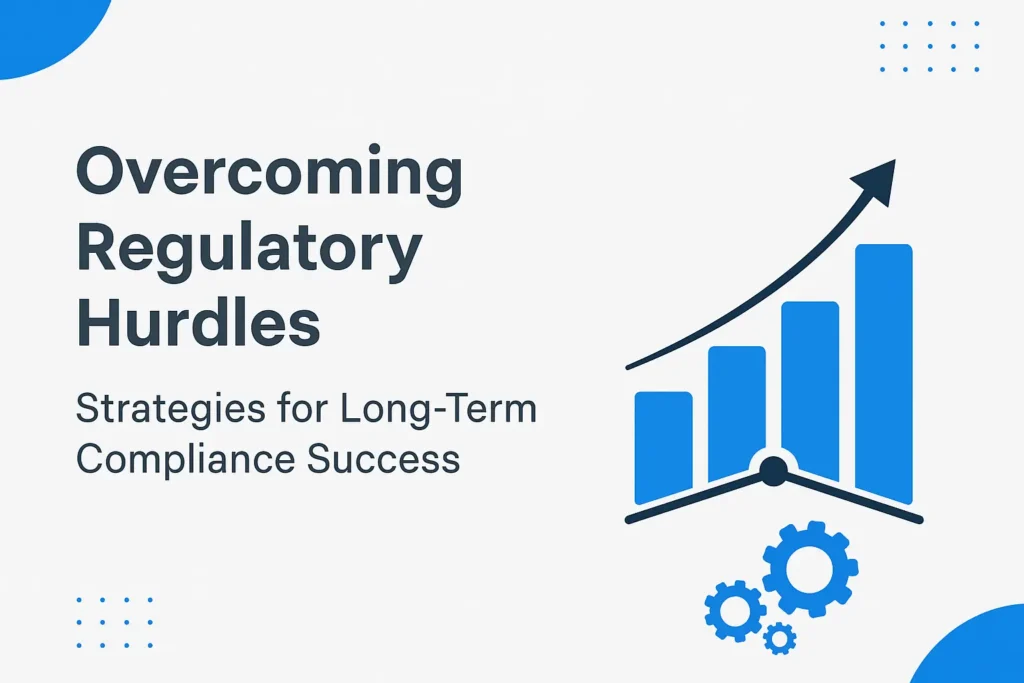Overcoming Regulatory Hurdles: Strategies for Long-Term Compliance Success
In today’s fast-paced business environment, overcoming regulatory hurdles is a mission-critical objective for startups, SMEs, and large enterprises alike. As global regulations become more complex, businesses must evolve to remain compliant and competitive. Below are proven strategies that can help organizations not only meet regulatory demands but also use compliance as a business enabler.
Understanding the Regulatory Landscape
The first step in overcoming regulatory hurdles is developing a deep understanding of the legal environment in which your business operates. Regulations can vary by country, state, and industry. For example, GDPR in Europe, HIPAA in the U.S., and SEBI norms in India impose very different compliance expectations.
According to a Thomson Reuters survey, over 74% of firms expect an increase in regulatory activity, making awareness and adaptability crucial. Monitoring government publications, regulatory agency updates, and industry-specific legal trends is essential.
Developing a Robust Compliance Framework
Once the landscape is understood, businesses must create a structured compliance framework. This includes formal policies, internal controls, monitoring mechanisms, and clearly defined accountability.
A strong framework typically involves a Chief Compliance Officer (CCO) or a dedicated team to implement and manage regulations across departments. Organizations that embed compliance into their operations experience fewer legal disputes and fines, ultimately easing the process of overcoming regulatory hurdles.
Leveraging Technology and Data Analytics for Compliance
Technology is revolutionizing how businesses approach compliance. Today, many companies use RegTech (Regulatory Technology) tools powered by AI and machine learning to automate compliance checks, risk assessments, and reporting.
For example, platforms like Thomson Reuters CLEAR and Wolters Kluwer OneSumX help companies track regulatory changes in real-time. By integrating compliance software with business operations, organizations not only reduce human error but also accelerate the process of overcoming regulatory hurdles through actionable insights.
Conducting Risk-Based Gap Analysis and Audits
A proactive strategy to mitigate compliance risks is conducting regular risk-based gap analyses. This process helps identify areas where current practices fall short of regulatory requirements.
Using a risk-based approach ensures resources are allocated efficiently—prioritizing areas of highest regulatory impact. According to Deloitte, companies that conduct regular internal audits reduce compliance costs by up to 30% over three years. These audits also help in building credibility with regulators and investors.
Fostering a Culture of Compliance through Training & Continuous Monitoring
Regulatory adherence is not just a technical or legal issue it’s a people issue. To truly succeed in overcoming regulatory hurdles, organizations must instill a culture of compliance.
This starts with training employees on relevant laws, internal policies, and ethical standards. Tools like LMS (Learning Management Systems) can automate and track training progress. Continuous monitoring, real-time alerts, and compliance dashboards ensure everyone remains informed of their responsibilities and changing regulations.
Collaborating with Regulatory Experts and Industry Associations
Sometimes the smartest way of overcoming regulatory hurdles is seeking external expertise. Regulatory consultants, compliance lawyers, and lobbying groups offer valuable insights that internal teams may miss.
Furthermore, membership in industry associations such as NASSCOM, BIO, or FINRA can provide access to regulatory trends, advocacy support, and pre-emptive guidance on upcoming rules. These partnerships not only accelerate approvals but also strengthen your business’s reputation with oversight bodies.
Conclusion
In a world where regulatory environments are continuously evolving, overcoming regulatory hurdles is no longer a one-time event it’s an ongoing strategic function. From understanding regulations to building resilient frameworks, leveraging technology, and nurturing a compliance-first culture, every step plays a pivotal role.
By proactively investing in these strategies, organizations can turn compliance into a competitive advantage minimizing legal risks while boosting stakeholder confidence.
More in Business Insider




